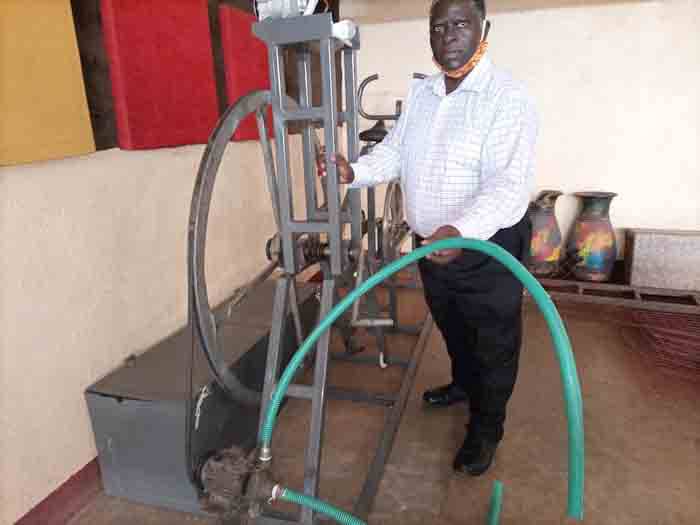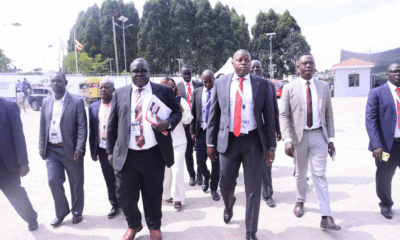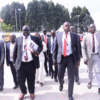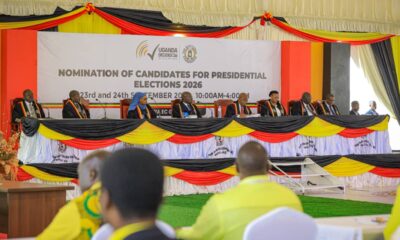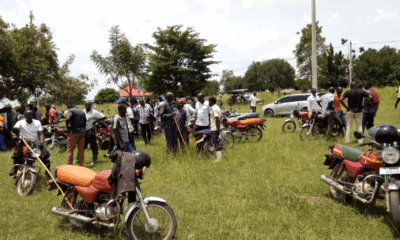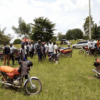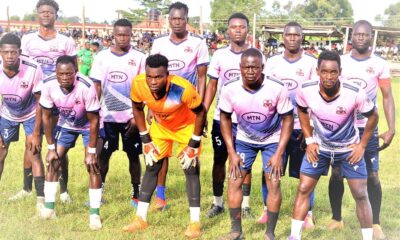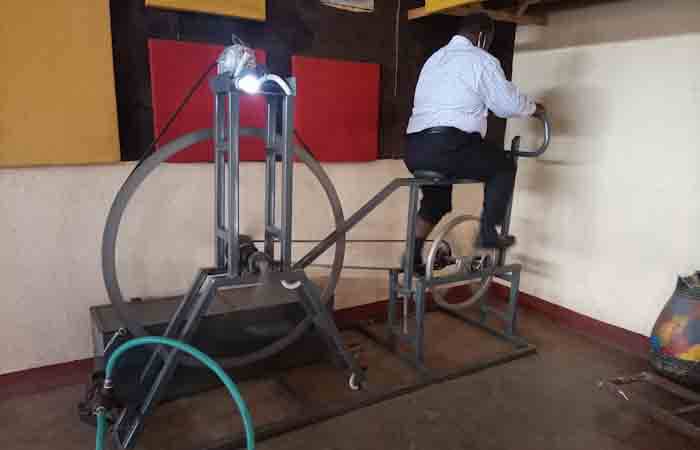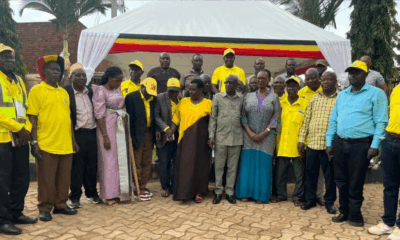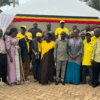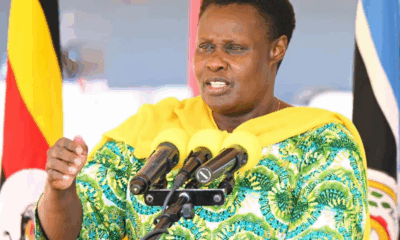News
Kibuuka’s power innovations
Kibuuka connecting a water pump
In our most recent publication, we brought you the story of John Fred Kibuuka, Uganda’s most decorated innovator, judging by the number of patents to his name. Last time we focused on his latest innovation, the Joshua Fire Quencher – for which he acquired after developing and successfully testing an electric-driven firefighting tool, that is more power compared to the commonly available fire extinguishers on the market.
In the second and last part of our report, we explore the three other technologies for which Kibuuka has been able to secure patents.
The Johnie MPF
This was Kibuuka’s very first innovation. It is called Johnie Multi-Purpose Function aka Johnie MPF. He named it after himself. He says he was motivated to develop the machine as a response to the power crisis that hit Uganda around 2008 following a prolonged drought that caused the electricity generated at Jinja to decline to low water levels in Lake Victoria.
Johnie MPF is a machine that is capable of generating electricity, pump water in a carefully calibrated combination that brings together several other gadgets like a wheel, a an alternator, an inverter, batteries and a water pump.
To generate electricity, the Johnie MPF requires a pedal cycle to run a huge wheel with a radius of about four feet and measuring about 40kgs in weight, which uses a belt to run an alternator to generate Alternating Current (AC) power.
The AC power that is generated is stored in the batteries and can be used as DC power, or can be converted back to AC power – using an inverter. The converted power can them be used to power numerous electrical simple appliances ranging from lights to television sets or a flat iron for pressing a few clothes.
Kibuuka built his machine just like a bicycle, although it differs in its functioning. Whereas the rear wheel of an ordinary bicycle moves pushes it forward through traction with the surface, the wheel on the Johnie MPF is suspended in the air but connected to an alternator using a belt.
The moment he starts to cycle, power is generated by the alternator. To enable later use of the power that is generated, he connected it to batteries and an electrical inverter that allows the system to avail stable electricity for use in a household such as powering electronics.
“The moment you start to pedal, before you finish one cycle, it will have started generating power.
The more vigorously you pedal, the more electricity you will be able to generate. You don’t have to pedal endlessly. You can pedal for about ten minutes, relax and pedal later. Every time you pedal, the power generated is stored in the battery like money is saved in the bank. It can only be released, if a connected appliance is switched on to discharge the battery,” Kibuuka remarks about the power of his innovation.
How much power can it generate?
According to Kibuuka, the Johnie MPF has the capacity to charge a battery with a capacity of up to 200AH (Amp Hours). Filling up the battery can take take up to three hours of normal cycling.
But 200AH is quite an amount of power because he says it can power at least 15 LED lights and a flat screen television with uninterrupted power for up to 12 hours.
“For me, it helped to solve my power challenges back in those days when we used to experience intermittent power cuts, even though I had decided to use it as a standby generator since I would not be able to do the pedalling all the time.”
He adds: “It can be able to power a three-bedroomed house like mine including powering electronics like a TV, a radio and a computer.
“Of course it has limitations including not being able to power things like a refrigerator or heating, because such appliances require a lot of power.
Although I am in the course of upgrading it so that it can accommodate many others, this (ambition) too has its own limitations since, as we’ve seen the power is stored in batteries. Adding the heavy-consuming gadgets would require a lot of batteries,” he says.
During its launch on October 26, 2016 at Lugogo UMA exhibition grounds, Kibuuka had the opportunity to showcase his innovation to a number of targeted visitors, especially the then newly appointed Minister of Science, Technology and Innovations Dr. Elioda Tumwesigye.
“I asked the Minister to do the pedalling which he pleasantly did for about 5 minutes. When he finished pedalling, I uncovered a table that we had gone with. It had a number of appliances.
I was able to switch on 12 lights that I had connected on a board which lit the whole place to almost day light. I also wetted my hanky and was able to iron it using a 1000Watt Philips flat iron.
Not only that, wehad carried a kilogram of groundnuts, which we were able to ground using the same charge. And we were able to do all those concurrently,” Kibuuka recalls that: “The minister and all those who witnessed our demonstration were truly stunned. The minister wondered, is this thing done here in Uganda, and I told him yes,”.
Kibuuka observers that if adopted, and commercialised, the Johnie MPF could have other social benefits such as strengthening marriages by empowering husbands with the ability to support their spouses with domestic chores such as grinding g-nuts or pressing clothes.
Johnie for Water Pumping
Besides generating electricity, the Johnie MPF can effectively work as a water pump.
Kibuuka carefully measured the point at which he fitted the pump to the ‘bicycle machine’ so that the machine uses the same belt to run the water pump.
“When it comes to the second function of Johnie MPF, all you have to do is shift the belt from the alternator to the hub that is connected with the water pump. The more vigorously you pedal, the more water will be pumped or transferred from one point to another.
Johnie MPF has the ability to draw water from under-the-surface tank or another water source as deep as 15 feet below the surface and throw it over a distance of 20 feet over the surface.
“Depending on how fast someone is pedalling, on average it will take between 20-30 minutes to fill up a water tank of 750 litres using
a ¾ inch horse pipe.
Kibuuka testifies that: “Besides generating power for my family, I could use the same machine to draw water from a 12-feet underground tank, transfer it to an overhead tank which would supply the house.”
The Gym
It is through the process of cycling to generate power or pump water that the third function of the machine is realised – physical exercise to the pedaller.
From the Fire quencher to the Johnie MPF, Kibuuka has secured two more patents related to power generation.
Theae are;t Self-Powered Pump Generator and The Rotational water system technology.
The Self-Powered Pump Generator, he says is an advancement of Johnie MPF to eliminate the manual aspect and make it gender-friendly.
The absence of a prototype, made it difficult for this write to analyze it and give details about it. Kibuuka himself attiributes the lack of a prototype to financial constraints obtain the parts he needed to build it. This he says though, it was never an obstacle for URSB to issue him with patent certificate.
The fourth technology under his name called the Rotational Water System Technology. This one is primarily meant to produce bigger volumes of electricity using water as the source of energy to move turbines that generate power.
“For lack of resources to develop prototypes or bring the innovations to reality, the experts granted me the patent after I submitted the relevant documentation and designs,” says Kibuuka.
Like all his innovations, the Rotational Water Technology was inspired by the need to solve a power crisis that plagued the country back in the 1990s.
“This is the very first design that I came up with. As I told you my innovations have been inspired by challenges. Around 1997 we had a prolonged drought that resulted into the water level in lake Victoria to decline so that the amount of power that could be generated, was very low. What I did was to go on my knees and ask God to give me wisdom to come up with a solution.
“As I meditated about it, I discovered that if I could be able to have a certain amount of water stored in a given place, use the same water over and over over again to run turbines to generate power in a cyclical way – hence the Rotational Water System Technology.”
“The technology I am talking about was met with a lot of controversy. Many scientists challenged me by saying that power is never created, no destroyed, it only changes shape. They said that running water of the river is what creates the energy. But I told them I am someone who is beyond that principal.”
“I was able to beat the principle. While they opposed it, I got to my knees and asked God to give me wisdom to prove them wrong. I was able to design the system and it worked,” he adds.
“In 2000 I took a trip to the United Kingdom and met a few people and when I explained my concept, they said no way.
That is impossible. I said to myself, okay this is how people think, I will proceed with my design,” he recalls.
“After a thorough examination by the panel of experts at URSB and after confirming from the Africa Regional Intellectual Property Organisation (ARIPO) that no such technology has ever been registered, they proceeded to grant me the patent,” says Kibuuka.
He is confident that if supported by the government, the Rotational Water System technology could eliminate the power challenge especially in rural areas, as a much lesser cost compared to what is needed to transfer and maintain transmission lines used these days.
Asked how much water it would require to build a functioning power station, Kibuuka responds by saying that the amount of power to be generated is determined by the capacity of the turbines that produce electricity, multiplied by the amount of water that is needed to run them per minute.
But he cautions that other factors such as momentum of the water would come into play to determine the power output.
“The thing is just not the calculations of amount of water per se, but also has other factors such as the momentum of the water and the space to store the water.”
Availability of the technologies
The excitement that comes from the fact that the innovation has several functions with enormous transformational power especially in Uganda’s situation, begs the question about its accessibility.
But after proving the concepts and successfully producing the prototypes, Kibuuka’s other problems start here. Although he has the ambition of modifying some of his technologies to make them easier to use, in their current form, many people would be interested in acquiring them.
Alas. Kibuuka doesn’t have the money to mass produce the innovations, except perhaps if an individual is willing to foot the costs. But the bigger challenge still, as he points out, surrounds his inability to obtain the parts from reputable manufacturers, to be able to assemble the machines faster and and at a lesser cost compared to fabricating them in Uganda.
Even then, Kibuuka argues that while it may bring a smile on his face by seeing his technologies serve the purposes for which he designed them, he believes that his calling is less in entrepreneurship and more in research.
“My job is to do research. My view is that if an entrepreneur can come up to me and expresses interest in mass-producing any of my technologies, and he/she agrees to pay me royalties, I am fine with that,” he says.
Kibuuka also feels that the relevant line ministry has not supported him to meet the heavy costs of advancing his research.
“I would want to go to countries like China where I can talk to manufacturers to design for me standardised wheels so that when they are brought here, the only job left is to assemble them. But I have knocked on the doors of the relevant officers in vain.”
As pointed out in our report last week, Kibuuka revealed that his relentless effort to secure assistance from the Ministry of Science, Technology and Innovation yielded a cold response from relevant officials.
Arthur Makara, the Commissioner for Science Advancement notes that the Ministry being new, they are still in the process of putting in place standardised procedures through which innovators can periodically access funding and other forms of support for innovators such as training, securing partnerships or other logistical suppor.
“The Ministry is in the process of coming up with a law that will govern the way to support innovators. This law will build on existing structures such as the Research and Innovation Committee, that sits regularly to vet proposals,” besides that, that innovator may not have received assistance perhaps because by the time he came there was no money.”
Makara says that the President asked the Ministry to provide the little funding that was available in the Ministry recently to Dr. Monica Musenero and Dr. Nambatya’s team at Mekerere which is involved in the effort to find a cure for COVID-19.
So, whereas a number of projects such as Kiira Electrical and Diesel Motor vehicle project have received the government’s support, it appears that these have been able to do so because they have attracted the President’s attention.
And as Makara has pointed, the absence of well developed institutions and structures that guide civil servants on who and how to fund innovations, innovators like Kibuuka, may continue to suffer unless the catch the attention of the president.
Comments



